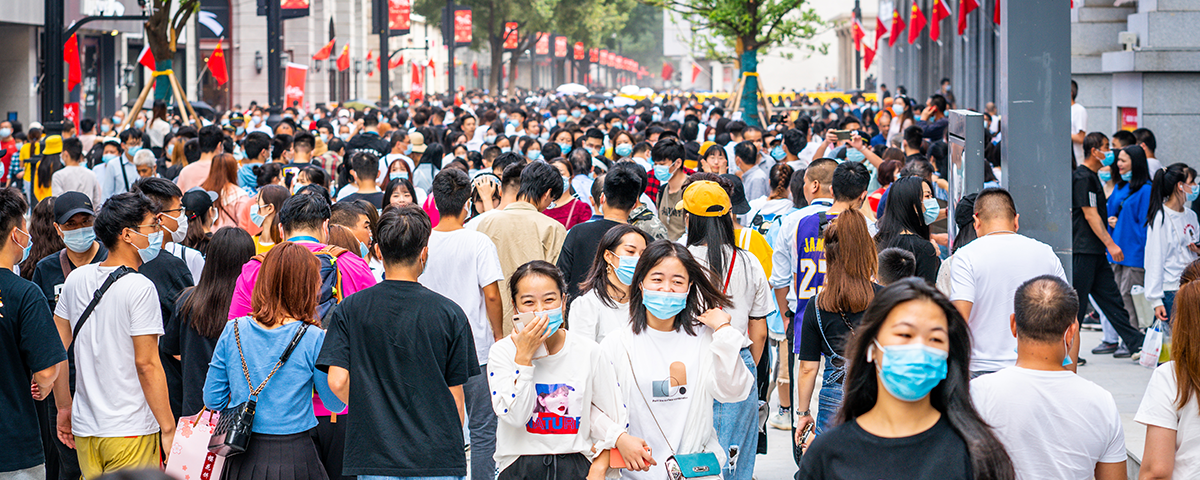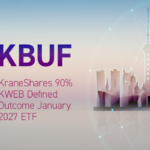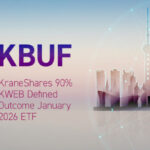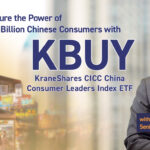
KBUY: Spotlight Shines on China Consumers
The Year of the Rabbit is off to a strong start as China remedies its COVID woes. Global investors are witnessing 1.4 billion consumers who spent three years in various stages of lockdown return to the market in force. We believe these consumers are unleashing a wave of “revenge spending” fueled by record-high household savings and favorable government policies, creating a compelling investment opportunity.
China’s top internet and E-Commerce companies, like Alibaba, JD.com, Trip.com, and Pinduoduo, are natural draws for investors. These companies make spending easy for consumers by providing an accessible platform and facilitating transactions. This is one reason our flagship KraneShares CSI China Internet ETF (Ticker: KWEB) is so popular with investors. However, the companies producing the goods and services that Chinese consumers buy may be equally as important as the platforms that deliver them.
Chinese sportswear brand Anta, condiment and spice manufacturer Haitian, restaurant Chain conglomerate Yum China, liquor and spirits producer Moutai, and many others are essential components of the entire China consumer opportunity. Accessing these stocks has been challenging as they are listed across multiple exchanges and underrepresented in many broad market indexes. This is where the KraneShares CICC China Consumer Leaders Index ETF (Ticker: KBUY) comes in. KBUY offers direct exposure to China’s top food & beverage, apparel, restaurants, appliances, and cosmetics stocks, regardless of where they are listed.
In the following report, we will provide an overview of the current state of the China consumer opportunity and why now may be an ideal time for investors to look at KBUY.
Impact
The COVID-19 pandemic significantly impacted the Chinese economy and society. The lockdowns and uncertainties decreased economic activity as businesses were forced to close and consumers curtailed spending. This led to a decline in employment and income as well as a rise in household savings as people tried to preserve their financial stability in the face of economic uncertainty. As seen in the chart below, China’s Consumer confidence index has dropped to a historically low level.

Chinese household net deposits reached an all-time high of 17.8 trillion RMB ($2.6 Trillion USD) in 20221. Also, China’s household savings rate spiked to 34% in 2022 compared to an 18% historical average prior.12 By comparison, in 2020, the US recorded a historically high savings rate among its consumers. However, we witnessed a sharp decrease in the US savings rate as the country accelerated its reopening in 2021, evidence that consumers were ready to spend savings heavily post-COVID. Once economic conditions in China stabilize, we can draw similar conclusions looking ahead to 2023. We believe pent-up demand and savings could cause a surge in revenge spending by China’s consumers.

Recent recovery
Recent data from the Chinese Lunar New Year holiday in late January signaled a quick rebound of consumer activities post-reopening. Tourism ministry data indicated a 23% rise in domestic trips during the seven-day period compared to last year. China’s travel booking company Trip.com saw 4x booking volume growth year-over-year (YoY) and even higher booking volume compared to the 2019 Lunar New Year.2
Additionally, the China Film Administration reported that around 129 million people crowded theaters over the Lunar holiday, generating almost one billion USD in movie box office revenue which is the second-highest box office holiday in China’s history.3 This bump in travel and consumer activity is a strong indicator that China’s consumer is ready to move past COVID and enjoy traditional leisure activities that were lost during the pandemic.
According to the Ministry of Commerce, dine-in spending grew by 15% over the Chinese New Year compared to last year’s holiday stretch4. Chinese hotpot restaurant chain Haidilao (1.24% of KBUY) serviced 6.5 million customers during the first five days of the Chinese New Year holiday, up 20% from a week prior5. Popular fast-food chains in China, including KFC and Pizza Hut, saw customers returning in volume post-reopening, benefiting its parent company Yum China (6.99% of KBUY).

Unsurprisingly, the travel and leisure sectors were the first industries to see a spike in volume. We believe that as the economy continues to gain footing and reestablish a sense of normality, consumer goods and products will be the next to benefit.
As in-person dining, meetings, and gatherings increase, we expect higher spirit and beer consumption in 2023. “Baijiu” is a traditional spirit for Chinese consumers when it comes to business meetings and family gatherings. People tend to purchase premium brands like Moutai (10.2% of KBUY) and Wuliangye (10% of KBUY) when meeting important clients or senior family members, which is a tradition dating back thousands of years. Local beer brands such as Tsingtao (1.9% of KBUY) and Snow beer, owned by China Resources Beer Group (3.5% of KBUY), are popular choices for casual fun and celebrations. The household name for soy sauce, “Haitian” (4.2% of KBUY), should also get more business as restaurants reopen.
The recent increase in outdoor activity also significantly benefits the apparel industry. People are beginning to meet publicly with friends and colleagues again, and with that comes a need for more outerwear, shoes, and jewelry. China has been trending towards domestic brands such as Anta (4.8% of KBUY) and Li Ning (4.7% of KBUY), which have gained popularity among millennials. Proya (1% of KBUY), a local cosmetic brand, saw significant sales growth in January, with online gross merchandise value (GMV) growth reaching 16% year over year from 9% a month ago.6

Policy support
The US government provided US consumers with over $5 trillion7 in support throughout the duration of the pandemic, including unemployment benefits and other aid. However, the Chinese government chose not to provide substantial relief money to consumers during the pandemic. This choice has allowed China to maintain a low inflationary environment as the consumer price index (CPI) YoY printed 2.1% in January 2023 vs. 6.4% in the US.8 This will ultimately allow the Chinese government to offer more supportive policies that will help improve consumer confidence.
Within Moody’s February 6th note, it upgraded its China 2023 gross domestic product (GDP) growth forecast to 4.9%, its first upward revision since August, while Fitch revised its projection to 5% from 4.1%, citing a faster-than-expected recovery in consumption and activity.9 The Chinese government has a target GDP growth of 5.5% for 2023. Encouraging consumers to spend becomes a top priority for the government if they want to achieve this growth target. President Xi said, "China must prioritize restoring and expanding consumer spending this year" at the Central Economic Work Conference, China's key annual meeting.10 China's Central Bank, the People's Bank of China (PBOC) and State Council have emphasized the importance of restoring market confidence, boosting consumption, and making it the primary driving force of the economy. In response, provincial governments, including Shanghai, Zhejiang, Jiangsu, and Guangdong, have swiftly announced several consumption stimulus plans. These plans include subsidies and reduced financing costs.11
Conclusion
China is returning to normal. We believe consumption-related companies will be direct beneficiaries of the country’s reopening. The recent recovery in the service sector will likely lead to a resurgence of demand for consumer products. As China’s inflation remains low and its high target for GDP growth remains intact, we believe there may be more policy support for the consumer market. In time, China will strive to rebalance its economy through consumption rather than investments and exports, which will create a long-term opportunity for the leading consumer brands in China.
The KraneShares CICC China Consumer Leaders Index ETF (Ticker: KBUY) consists of Mainland China, Hong Kong, and US-listed China-based companies whose primary business or businesses are in the consumption-related industries such as food & beverage, apparel & clothing, home appliances, restaurants, and cosmetics, etc.


For KWEB standard performance, top 10 holdings, risks, and other fund information, please click here.
For KBUY standard performance, top 10 holdings, risks, and other fund information, please click here.
Percentage of companies mentioned throughout content is from Bloomberg as of 1/31/2023. Holdings are subject to change.
Citations:
- Data from Bloomberg as of 1/31/2023.
- Trip.com 2023 Chinese New Year Tourism Report as of 1/30/2023.
- "Analysis: China Had Some Strong Holiday Spending Numbers, but Don’t Break Out the Champagne", Caixin, February 2023.
- "China’s Consumer Inflation Picks Up as Recovery Gathers Pace", Caixin, February 2023.
- "China Banks Offer Cheap Consumer Loans as Xi Urges More Spending", Caixin, February 2023.
- Data from China Renaissance as of 2/15/2023.
- "COVID Money Tracker by the Committee for a Responsible Federal Budget, a Washington think tank", CRFB, February 2022.
- Data from Bloomberg as of 2/14/2023.
- "China’s Consumer Inflation Picks Up as Recovery Gathers Pace", Caixin, February 2023.
- "Xi Says China Must Boost Consumer Spending, Foreign Investment This Year", Caixin, February 2023.
- Data from SCMP as of 1/31/2023.
- Data from Bloomberg as of 1/31/2023.
Definitions:
Household Net Deposits: Household net deposits refer to the total amount of money that households have deposited into financial institutions, such as banks and credit unions, minus any withdrawals or transfers out of those accounts. It is a measure of the net inflow of funds into households' savings and checking accounts over a specific period of time.
Household Savings Rate: The household savings rate is a measure of the percentage of disposable income that households save. It is calculated by dividing the amount of money that households save in a given period (usually a year) by their disposable income, which is their income after taxes and other mandatory deductions.
Gross Merchandise Value (GMV): GMV is the value of goods sold via customer-to-customer or e-commerce platforms. Gross merchandise value is calculated prior to the deduction of any fees or expenses. It is a measure of the growth of the business or use of the site to resell products owned by others through consignment.
Consumer price Index (CPI): CPI measures the monthly change in prices paid by U.S. consumers. The Bureau of Labor Statistics (BLS) calculates the CPI as a weighted average of prices for a basket of goods and services representative of aggregate U.S. consumer spending.
Gross Domestic Product (GDP): GDP is the total monetary or market value of all the finished goods and services produced within a country’s borders in a specific time period.

















